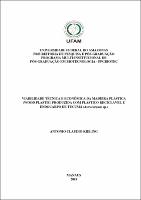| ???jsp.display-item.social.title??? |


|
Please use this identifier to cite or link to this item:
https://tede.ufam.edu.br/handle/tede/6806| ???metadata.dc.type???: | Tese |
| Title: | Viabilidade técnica e econômica da madeira plástica (wood plastic) produzida com plástico reciclável e endocarpo de tucumã (Astrocaryum sp.) |
| Other Titles: | Technical and economical feasibility of plastic wood produced with recyclable plastic and tucuman endocarbus (Astrocaryum sp.) |
| ???metadata.dc.creator???: | Kieling, Antônio Cláudio  |
| ???metadata.dc.contributor.advisor1???: | Santos, Maria Cristina dos |
| First advisor-co: | Santana, Genilson Pereira |
| ???metadata.dc.contributor.referee1???: | Faria, Marlene Araújo de |
| ???metadata.dc.contributor.referee2???: | Giacon, Virgínia Mansanares |
| ???metadata.dc.contributor.referee3???: | Castro, Rebecca Freire de |
| ???metadata.dc.contributor.referee4???: | Vieira, Raimundo Kennedy |
| ???metadata.dc.description.resumo???: | A viabilidade econômica e produtiva de madeira plástica (wood plastic) em Manaus foi desenvolvida neste trabalho. Inicialmente, a cadeia de comercialização do tucumã foi caracterizada, a fim de estabelecer a distribuição dos vendedores e pontos de fornecimento do fruto nas zonas da cidade. Numa segunda etapa, realizou-se uma investigação da produção de resíduos plásticos recicláveis, de acordo com as zonas da cidade, visando aumentar a quantidade de informações. Além disso, foram propostas estratégias baseadas no estudo de viabilidade econômica para a implantação de programas de reciclagem, segundo as melhores regiões da cidade. Na terceira etapa, uma revisão abordando vários aspectos da cadeia produtiva, como evolução histórica, composição, produção e aplicação da wood plastic em termos mundiais foi apresentada. Numa quarta etapa, a possibilidade de produzir wood plastic a partir da mistura de polietileno de baixa densidade (PEBD) e do endocarpo do tucumã é reportada. Diante do sucesso da produção de wood plastic com PEBD foi obtido e caracterizado compósito de wood plastic obtido a partir da mistura de polipropileno (PP) e do endocarpo do tucumã. Neste trabalho é possível observar que com as quantidades de endocarpo lenhoso e de PP descartados no ambiente, seria possível injetar na economia local cerca de R$ 3,58 milhões anuais para serem aplicados em uma gama de possibilidades de produtos, tais como placas de pisos e revestimentos, suporte de telefones celulares, porta-retratos, pranchetas, etc. Em contrapartida atualmente são descartados anualmente R$ 46 milhões em plásticos recicláveis no aterro sanitário da AM-10 que poderiam ser reaproveitados comercialmente. |
| Abstract: | The economical and productive viability of wood plastic in Manaus was developed in this work. Initially, the marketing chain of the tucumã was characterized in order to establish the distribution of the vendors and points of supply of the fruit in the zones of the city. In a second stage, an investigation was carried out into the production of recyclable plastic waste, according to the city zones, aiming to increase the amount of information. In addition, strategies were proposed based on the economic viability study for the implementation of recycling programs according to the best regions of the city. In the third step, a review covering several aspects of the production chain, such as historical evolution, composition, production and application of wood plastic in world terms was presented. In a fourth step, the possibility of producing wood plastic from the mixture of low-density polyethylene (LDPE) and the endocarp of tucumã is reported. Due to the success of the production of wood plastic with LDPE, a composite of wood plastic obtained from polypropylene (PP) and the endocarp of tucumã was obtained. In this work it is possible to observe that with the quantities of woody endocarp and PP discarded in the environment, it would be possible to inject in the local economy around R$ 3.58 million per year to be applied in a range of product possibilities, such as floor plaques and coatings, support of cell phones, picture frames, clipboards, etc. In contrast, R$ 46 million in recyclable plastics are disposed annually in the sanitary landfill of the AM-10 that could be reused commercially. |
| Keywords: | Cadeia Produtiva Reciclagem Compósitos Comercialização de Recicláveis Upcycling Production Chain Recycling Composites Commercialization of Recyclables Upcycling |
| ???metadata.dc.subject.cnpq???: | CIÊNCIAS BIOLÓGICAS ENGENHARIAS: ENGENHARIA DE MATERIAIS E METALÚRGICA: MATERIAIS NÃO METÁLICOS: POLÍMEROS, APLICAÇÕES CIÊNCIAS SOCIAIS APLICADAS: ADMINISTRAÇÃO: ADMINISTRAÇÃO DE EMPRESAS: ADMINISTRAÇÃO DA PRODUÇÃO |
| Language: | por |
| ???metadata.dc.publisher.country???: | Brasil |
| Publisher: | Universidade Federal do Amazonas |
| ???metadata.dc.publisher.initials???: | UFAM |
| ???metadata.dc.publisher.department???: | Instituto de Ciências Biológicas |
| ???metadata.dc.publisher.program???: | Programa de Pós-Graduação em Biotecnologia |
| Citation: | KIELING, Antônio Cláudio. Viabilidade técnica e econômica da madeira plástica (wood plastic) produzida com plástico reciclável e endocarpo de tucumã (Astrocaryum sp.). 2018. 150 f. Tese (Doutorado em Biotecnologia) - Universidade Federal do Amazonas, Manaus, 2018. |
| ???metadata.dc.rights???: | Acesso Aberto |
| ???metadata.dc.rights.uri???: | http://creativecommons.org/licenses/by-nc-nd/4.0/ |
| URI: | https://tede.ufam.edu.br/handle/tede/6806 |
| Issue Date: | 7-Dec-2018 |
| Appears in Collections: | Doutorado em Biotecnologia |
Files in This Item:
| File | Description | Size | Format | |
|---|---|---|---|---|
| Tese_Antonio Claudio KielingPPGBIOTEC | 5.46 MB | Adobe PDF |  Download/Open Preview |
This item is licensed under a Creative Commons License





